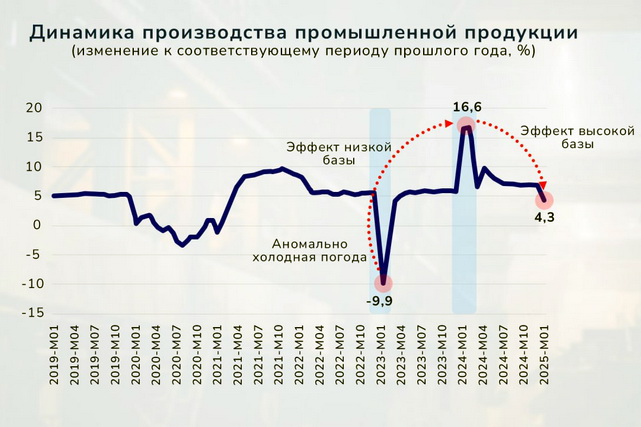
Is industrial growth in Uzbekistan slowing down? The effects of low and high base factors
Is industrial growth in Uzbekistan slowing down? The effects of low and high base factors
Tashkent, Uzbekistan (UzDaily.com) — In January of this year, industrial production grew by 4.3%, which is a strong indicator of enterprise activity at the beginning of the year and a promising sign for continued economic performance in the coming months.
Of course, when compared to January of the previous year, when industrial production surged by a record 16.6%, the current growth rate may not seem as impressive. However, it is too early to conclude that there is a trend toward slowing growth.
A fundamental economic principle is the tendency toward equilibrium between supply and demand for goods. However, the conditions under which enterprises operate and consumer needs constantly evolve. When significant changes occur, there may be temporary sharp increases or declines in production, which persist until the market reaches a new balance.
Once equilibrium is restored, production returns to its long-term norm, which may be reflected in either lower (high base effect) or higher (low base effect) growth rates.
The January 2025 industrial growth rate reflects precisely this high and low base effect phenomenon. The sharp rise in January 2024 was largely due to a nearly 10% drop in production in January–February 2023, caused by disruptions in manufacturing processes due to abnormally cold weather in the region.
Thanks to timely government measures to support industrial production, the downturn was quickly offset, allowing for a transition to a period of sustained growth.
In fact, of the 16.6% industrial growth recorded in January 2024, more than 10 percentage points were attributed to production recovery, while only 5–6 percentage points represented net growth in production.
This suggests that in the current period, we are likely seeing a normalization of trends. One key indicator of this is the accelerated growth in the manufacturing sector, which has the greatest potential for producing high-value-added goods.
In January 2025, the manufacturing sector showed one of the highest growth rates, at 5.2%. The sector’s share in total industrial production increased from 75.7% in January 2024 to 79.1% in January 2025. The measures aimed at expanding the manufacturing industry are facilitating the development of high-tech production focused on value-added goods.
By the end of January 2025, most high- and medium-tech industries showed positive growth, supported by state incentives. As a result, these industries demonstrated the strongest industrial optimism.
The growth rates in specific technology-intensive sectors were particularly noteworthy:
Computers and electronics: 107.7%
Electrical equipment: 114.5%
Various types of machinery, including transport equipment: 142.7%
The contribution of these sectors to the overall growth of the engineering industry, which falls under high- and medium-tech categories, continues to rise dynamically.
Despite a temporary slowdown in the automotive sector, engineering as a whole accounted for 12.3% of total industrial output.
Alongside the development of high-tech industries, consumer-oriented sectors are also expanding, helping to increase the supply of domestically produced goods on the local market.
In January 2025, several consumer-oriented industries showed positive growth, including:
Food industry: 112.7%
Textiles: 103.6%
Clothing: 101.3%
Furniture: 116.7%
Paper products: 137.6%
This growth not only met domestic demand for these products but also boosted exports.
The mining sector also returned to positive territory in January, with a growth rate of 102.3%, partially due to the low base effect from the previous year.
The decline in natural gas, oil, and condensate production, caused in part by deteriorating resource conditions, was offset by an increase in energy imports. Timely actions to secure additional imports of key energy resources helped prevent energy shortages, ensuring stable electricity and heating supply for enterprises and households. Particular priority was given to supporting the population.
An increase in coal production also contributed to enhanced energy supply, which was especially critical during the cold season.
Additionally, the energy sector played a significant role in economic stability, driven by:
A 1.46-fold increase in heat energy supply
A 2.8-fold growth in electricity production by small enterprises (according to statistical surveys)
Overall, total electricity generation (including large enterprises) exceeded 7.2 billion kWh.
The January industrial production index remains firmly in positive territory, signaling optimism for further growth throughout the year. The forecast for 2025 suggests a 6.1%–6.2% expansion, which is highly achievable.
This optimism is further reinforced by comparative analysis with Uzbekistan’s trading partners. For instance, industrial growth in Uzbekistan in January 2025 outpaced that of Kazakhstan by 2 percentage points (Uzbekistan: 104.3%, Kazakhstan: 102.3%).
From a structural perspective, Uzbekistan’s industrial sector is well-positioned for further expansion due to the efficient integration of manufacturing potential.
Achieving the projected growth targets will depend on effectively mobilizing existing reserves to expand high-value-added manufacturing industries. This remains a priority in the country’s industrial policy.